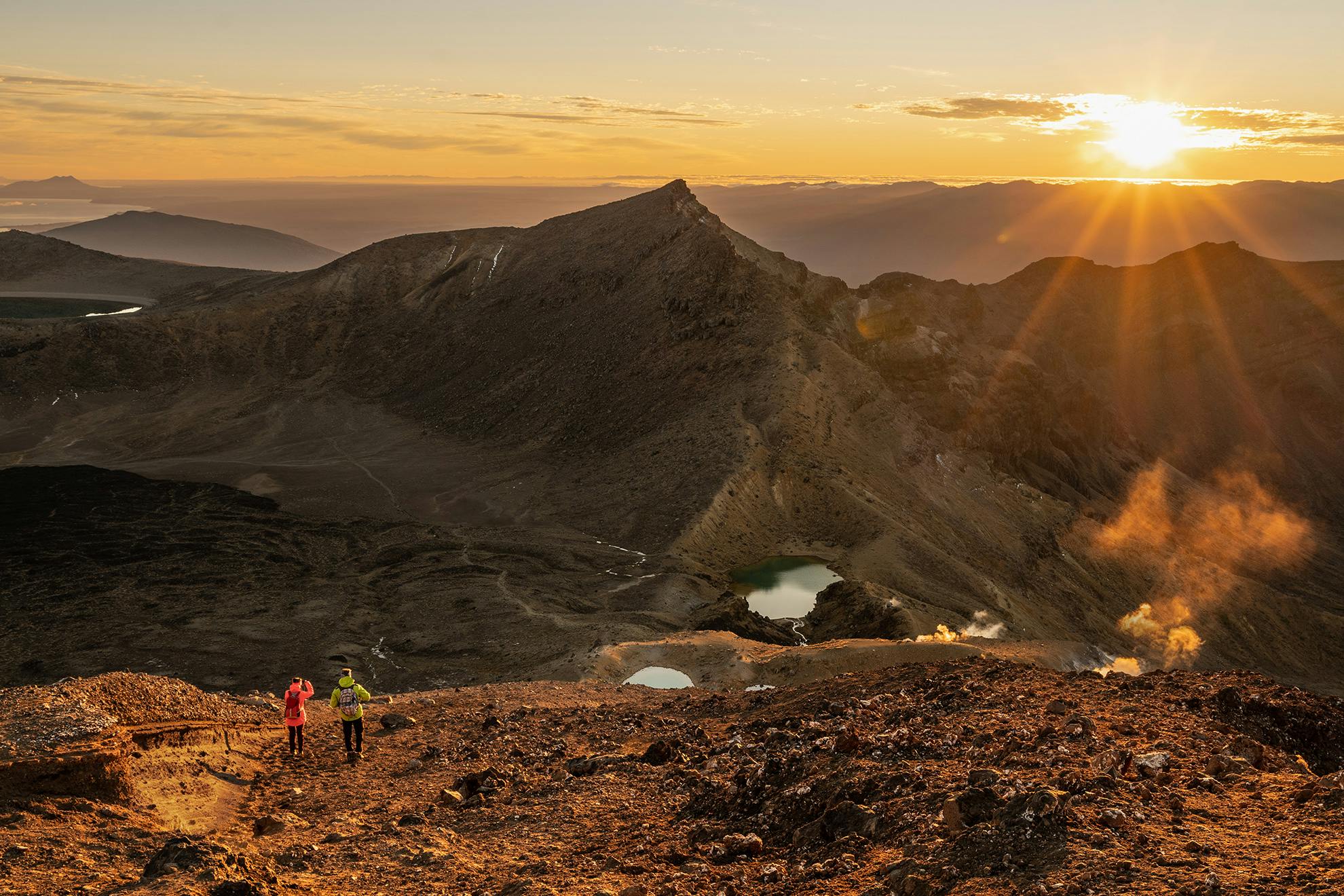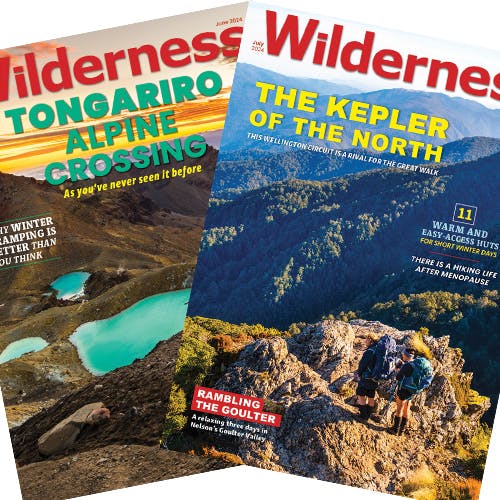One way to beat the crowds on the Tongariro Alpine Crossing – aka the most popular day walk in New Zealand – is to walk it by moonlight. By Logan Voss
The Tongariro Alpine Crossing is one of New Zealand’s best-known and most popular day walks. In summer, hundreds of international and local tourists tackle it each day. Most start on the Mangatepōpō side near National Park Village and finish at the Ketetahi car park on the northern slopes of Mt Tongariro. DOC figures show that 122,200 people walked the TAC in the 2019/20 season. Assuming a five-month window (October–April), that’s an average of around 800 people per day! Gone are the days when this slice of wilderness could be explored in relative solitude, at least in the summer season when the high-altitude sections of the track are reliably ice and snow-free.
I was introduced to the TAC as a boy in the 1980s, when school groups would stay at Mangatepōpō camp and explore the Mangatepōpō Valley with little competition for track space. In the four decades since, I have walked the crossing 10 times.
Enter my 21-year-old son James who, at the beginning of the year, had not done the TAC even once. We got to thinking: was there any reason we couldn’t rediscover the glory days of solitude on the track by walking the Crossing at night? That would be a unique experience! We started planning. The non-negotiables were a clear moonlit night, settled weather and light winds.

Our first attempt, in February, was thwarted by cloud and wind. With work commitments for the new year looming, the idea was shelved.
A couple of months later, at an Easter family gathering around the dining table, our conversation turned to my intention to indulge a landscape photography addiction in Tongariro National Park the following evening. A quick look at the mountain weather forecast for the rest of the weekend showed conditions were ideal, and the moonlit TAC idea was reignited.
We booked a motel in Tūrangi for Sunday night and started gathering what we needed. The plan was simple: to be packed and ready to go at the motel on Sunday afternoon, early to bed and on the track at the Mangatepōpō entrance by 3am. We intended to be at Red Crater (at 1866m the highest point on the walk) at 7.30am to catch the sunrise. The early start would give us plenty of time to experiment with some moonlit photography on the way.
Figuring that the four-hour parking limit was unlikely to be enforced at 3am, we left our car at the Mangatepōpō car park and set off, head torches fully charged. Although we assumed we would need torches most of the way, we were keen to see if we could do it by the light of the quarter moon. We started with our lamps off to test our eyes in the environment, and it soon became clear (no pun intended) that the moonlight was more than sufficient. In fact, as our eyes adjusted to the ambient light we were able to take in the surroundings, which would have been invisible to headlamp-adjusted eyes. We made our way quietly up the valley, periodically flicking our torches on to check for track markers or to pick snacks from our bags.


Our initial designated photography stop was most of the way up the 200m Devil’s Staircase. This was a unique opportunity to experiment with some photographic techniques, and James had a couple of ideas he wanted to try. The first was a light trail along the track within a panorama of the surrounding moonlit landscape, looking down on the Mangatepōpō Valley. The second was a selfie on the track, illuminated by a headlamp placed strategically on a rise some distance away. Both proved technically tricky, especially as our hands got progressively colder. Most of the frames were shot by trial and error because there wasn’t sufficient light to bring the electronic viewfinders to life on the cameras. We would later discover that our moonlight-adjusted eyes had tricked us into believing the shots were better exposed than they were. Fortun- ately, with modern high dynamic-range cameras, raw digital files and some AI-assisted noise reduction (yes, these shots were quite heavily post-processed), we were able to turn the black images on our computer into some (just) usable images.
The cold eventually became too much and we packed up our tripods and cameras and set off across the South Crater. Photographing the sunrise from Red Crater would be an easier assignment.
We had idly wondered whether we would cross paths with anyone else and were both convinced we wouldn’t be alone. Embarrassingly, I was convinced that a particularly bright spot of light halfway up the slopes of Mt Ngāuruhoe was some sort of camp, but in the light of day it became apparent that it had been a remnant of ice reflecting the moonlight. Initial deception aside, sure enough, as we made our way up the second climb to the top of Red Crater, the light from a distant headlamp popped up on the far side of South Crater.

We reached Red Crater summit via the steepest section of track at 6.30am. We were a little early, an hour before sunrise on the most exposed section of track, and congratulated ourselves on picking the perfect windless night. Despite the track being frozen underfoot, we had no trouble keeping warm in our layers, beanies and gloves. As the sky brightened and the sun rose, there were photo opportunities in all directions. The owners of the headlamp, a young couple, eventually joined us on the summit and were gracious in hiding their disappointment at discovering we had gatecrashed their epic romantic sunrise location.
The scramble down to Ngā Rotopounamu Emerald Lakes, past Te Wai Whakaata o te Rangihīroa Blue Lake and on to the lower slopes of Mt Tongariro, was more reminiscent of my previous experiences, but this time in the pleasant warmth of morning sunlight. The warm hues of the rising sun transformed the landscape. Although beautiful in its own unique way, the bleakness of the terrain in the dim moonlight did have a slightly imposing, claustrophobic effect.
We shed layers quickly as the temperature climbed, and were impressed by some young trail runners who blazed past us on the way down, looking as fresh as ever. My 52-year-old legs were far from fresh and complained more than normal during the relentless downhill. Thank goodness for the walking pole that I had included almost as an afterthought, and which may now be a permanent feature of my walking kit.
We arrived at the Ketetahi car park around 11.30am and were met by my wife. Back at the Mangatepōpō car park, we were pleased to discover we hadn’t been ticketed for our lengthy stay. Upon seeing the crowds starting the track, we congratulated ourselves again for picking not only the perfect day, but the perfect time of day.







